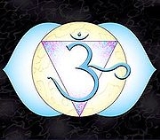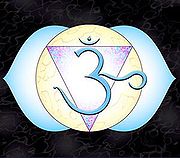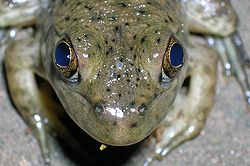
Ajna
Encyclopedia

Ajna is the sixth primary chakra
Chakra
Chakra is a concept originating in Hindu texts, featured in tantric and yogic traditions of Hinduism and Buddhism. Its name derives from the Sanskrit word for "wheel" or "turning" .Chakra is a concept referring to wheel-like vortices...
according to Hindu
Hindu
Hindu refers to an identity associated with the philosophical, religious and cultural systems that are indigenous to the Indian subcontinent. As used in the Constitution of India, the word "Hindu" is also attributed to all persons professing any Indian religion...
tradition.
Location
The Ajna chakra is positioned in the brain, directly behind the eyebrow centre, while its ksehtram or superficial activation site is at the eyebrowEyebrow
The eyebrow is an area of thick, delicate hairs above the eye that follows the shape of the lower margin of the brow ridges of some mammals. Their main function is to prevent sweat, water, and other debris from falling down into the eye socket, but they are also important to human communication and...
region, in the position of the 'third eye'.
Appearance
Ajna is white in colour, with 2 white petals. Inside of the pericarp is the Shakti Hakini, who is moon white, with 6 faces, and 6 arms, holding a book, a skull, a drum, a rosary, and making the gestures of granting boons and dispelling fears. Above her is a downward pointing triangle, within which is a moon-white lingum. In some systems the deityDeity
A deity is a recognized preternatural or supernatural immortal being, who may be thought of as holy, divine, or sacred, held in high regard, and respected by believers....
Ardhanarishvara a hermaphrodite form of Shiva
Shiva
Shiva is a major Hindu deity, and is the destroyer god or transformer among the Trimurti, the Hindu Trinity of the primary aspects of the divine. God Shiva is a yogi who has notice of everything that happens in the world and is the main aspect of life. Yet one with great power lives a life of a...
-Shakti
Shakti
Shakti from Sanskrit shak - "to be able," meaning sacred force or empowerment, is the primordial cosmic energy and represents the dynamic forces that are thought to move through the entire universe in Hinduism. Shakti is the concept, or personification, of divine feminine creative power, sometimes...
, symbolising the primordial duality of subject and object, resides within the lingum. Above the triangle is another smaller triangle, within which is the bija mantra Aum.
Petals
Ajna has two white petalPetal
Petals are modified leaves that surround the reproductive parts of flowers. They often are brightly colored or unusually shaped to attract pollinators. Together, all of the petals of a flower are called a corolla. Petals are usually accompanied by another set of special leaves called sepals lying...
s, said to represent the psychic channels
Nadi (yoga)
' are the channels through which, in traditional Indian medicine and spiritual science, the energies of the subtle body are said to flow. They connect at special points of intensity called chakras...
, Ida and Pingala, which meet here with the central Sushumna nadi (channel) before rising to the crown chakra, Sahasrara
Sahasrara
Sahasrara/ Sahastrara is the seventh primary chakra according to Hindu tradition.-Location:Sahasrara is either located at the top of the head in that one area, or a little way above it .-Appearance:Sahasrara is described with 1,000 multi-coloured petals which are arranged in 20 layers each of them...
. Written upon them in white are the letters 'Ham' on the left petal, and 'ksham' on the right petal, representing Shiva
Shiva
Shiva is a major Hindu deity, and is the destroyer god or transformer among the Trimurti, the Hindu Trinity of the primary aspects of the divine. God Shiva is a yogi who has notice of everything that happens in the world and is the main aspect of life. Yet one with great power lives a life of a...
and Shakti
Shakti
Shakti from Sanskrit shak - "to be able," meaning sacred force or empowerment, is the primordial cosmic energy and represents the dynamic forces that are thought to move through the entire universe in Hinduism. Shakti is the concept, or personification, of divine feminine creative power, sometimes...
, respectively.
These petals also represent the manifest and unmanifest mind, and are said by some to represent the pineal and pituitary glands.
Function
Ajna translates as 'command', and is considered as the eye of intuition. When something is seen in the mind's eyeMind's eye
The phrase "mind's eye" refers to the human ability for visualization, i.e., for the experiencing of visual mental imagery; in other words, one's ability to "see" things with the mind.- Physical basis :...
, or in a dream, it is being 'seen' by Ajna. It is a bridge that links gurus with disciples, allowing mind communication to occur between two people. The sense organ and action organ associated with Ajna is the mind in both cases.
Hindus believe that spiritual energy from the external environments enter their body through this gateway and hence take utmost precaution in protecting it with spiritually positive protecting forces. The various religious marks one sees on the foreheads of men and women belonging to the Hindu faith (like holy ash,namam, vermilion etc. ) are thus the blessed spiritual prasadam of their respective form of the Hindu gods.
Meditation upon Ajna supposedly grants the following siddhis or occult powers; to quickly enter anothers body at will; to become omniscient; he realizes unity with Brahman; and he has the ability to create, preserve and destroy the 3 worlds.
Manas Chakra
Directly above Ajna is a minor chakra known as Manas, or mind. It possesses 6 petals, one for each of the 5 senses, and one for sleep. These petals are normally white, but assume the colour of the senses when activated by them, and they are black during sleep. It's function is to send sense perceptions to the higher chakras.Association with the body

Pineal gland
The pineal gland is a small endocrine gland in the vertebrate brain. It produces the serotonin derivative melatonin, a hormone that affects the modulation of wake/sleep patterns and seasonal functions...
, and sometimes with the pituitary gland
Pituitary gland
In vertebrate anatomy the pituitary gland, or hypophysis, is an endocrine gland about the size of a pea and weighing 0.5 g , in humans. It is a protrusion off the bottom of the hypothalamus at the base of the brain, and rests in a small, bony cavity covered by a dural fold...
. The pineal gland is actually related to a real, light sensitive 'third eye' (Parietal eye
Parietal eye
A parietal eye, also known as a parietal organ or third-eye or pineal eye, is a part of the epithalamus present in some animal species...
) found in some lizards, amphibians and fish, and regulates the circadian rhythms, while the Pituitary Gland is considered as the master gland of all endocrine glands, whose secretions control all the other endocrine glands.
Practices
In kundalini yogaKundalini yoga
Kundalini yoga is a physical, mental and spiritual discipline for developing strength, awareness, character, and consciousness. Practitioners call Kundalini yoga the yoga of awareness because it focuses primarily on practices that expand sensory awareness and intuition in order to raise individual...
, different practices are said to stimulate the Ajna chakra, including Trataka
Trataka
Trataka is the practice of staring at some external object. It is used in yoga as a way of developing concentration, strengthening the eyes, and stimulating the Ajna chakra....
(steady gazing), Shambhavi Mudra
Mudra
A mudrā is a symbolic or ritual gesture in Hinduism and Buddhism. While some mudrās involve the entire body, most are performed with the hands and fingers...
(gazing at the space between the eyebrows), and some forms of Pranayama
Pranayama
Pranayama is a Sanskrit word meaning "extension of the prana or breath" or more accurately, "extension of the life force". The word is composed of two Sanskrit words, Prāna, life force, or vital energy, particularly, the breath, and "āyāma", to extend, draw out, restrain, or...
(breath exercises).
Comparisons with other systems
In Tibetan buddhism, this chakra is at the end of the central channel, which in their system runs up the body to the top of the head, and then over and down to the forehead, where it terminates. The 2 side channels then continue onwards towards the 2 nostrils, and end there. This centre is frequently depicted in artwork as the 'third eye', and is used in various meditations.There is also a forehead centre above the third eye, which corresponds to the position of Manas, known as the Wind Wheel, which is one of the 10 chakras in the Mahayoga tantra traditions.
In Qigong, the highest Dantian
Dantian
Dantian, dan t'ian, dan tien or tan t'ien is loosely translated as "elixir field". It is described as an important focal point for internal meditative techniques.There are various points of dantian...
is located in this position. This is one of 3 'furnaces' that converts the different sorts of energy in the body. In this Dantian, the spiritual shen
Shen (Chinese religion)
Shen is a keyword in Chinese philosophy, Chinese religion, and Traditional Chinese Medicine.-Pronunciation:Shén is the Modern Standard Chinese pronunciation of 神 "spirit; god, deity; spiritual, supernatural; awareness, consciousness etc". Reconstructions of shén in Middle Chinese Shen is a...
energy is converted into wuji, the infinite space of void
Within the system of Lataif-e-sitta
Lataif-e-sitta
Lataif-as-Sitta are psychospiritual "organs" or, sometimes, faculties of sensory and suprasensory perception in Sufi psychology. They are thought to be parts of the self in a similar manner to the way glands and organs are part of the body...
there exists a Lataif known as Khafi, or arcane subtlety, in this same position, and is related to mystical intuition.
In the Kabbalah
Kabbalah
Kabbalah/Kabala is a discipline and school of thought concerned with the esoteric aspect of Rabbinic Judaism. It was systematized in 11th-13th century Hachmei Provence and Spain, and again after the Expulsion from Spain, in 16th century Ottoman Palestine...
, there are 2 sephiroth located on the 6th level, associated with the left and right eye. They are called Chokmah, wisdom, and Binah
Binah
Binah may refer to:* Binah, Togo, a prefecture of Togo* Binah , the second intellectual Sephirah on the tree of life in the Kabbalah of Judaism* Binah , a Jewish women's weekly magazine published in the United States...
, understanding, and it is at these points that the 2 side pillars of mercy and severity terminate, while the central pillar carries on rising to kether, the crown.
Alternative names
- In TantraTantraTantra , anglicised tantricism or tantrism or tantram, is the name scholars give to an inter-religious spiritual movement that arose in medieval India, expressed in scriptures ....
: Ajita-Patra, Ajna, Ajna-Pura, Ajna-Puri, Ajnamhuja, Ajnapankaja, Bhru-Madhya, Bhru-Madhya-Chakra, Bhru-Madhyaga-Padma, Bhru-Mandala, Bhru-Mula, Bhru-Saroruha, Dwidala, Dwidala-Kamala, Dwidalambuja, Dwipatra, Jnana-Padma, Netra-Padma, Netra-Patra, Shiva-Padma, Triweni-Kamala - In the VedasVedasThe Vedas are a large body of texts originating in ancient India. Composed in Vedic Sanskrit, the texts constitute the oldest layer of Sanskrit literature and the oldest scriptures of Hinduism....
, UpanishadUpanishadThe Upanishads are philosophical texts considered to be an early source of Hindu religion. More than 200 are known, of which the first dozen or so, the oldest and most important, are variously referred to as the principal, main or old Upanishads...
s: Ajna, Baindawa-Sthana, Bhru Chakra, Bhruyugamadhyabila, Dwidala - In the PuranasPuranasThe Puranas are a genre of important Hindu, Jain and Buddhist religious texts, notably consisting of narratives of the history of the universe from creation to destruction, genealogies of kings, heroes, sages, and demigods, and descriptions of Hindu cosmology, philosophy, and geography.Puranas...
: Ajna, Dwidala, Trirasna
| PLEASE BE CAUTIOUS IN ADDING MORE LINKS TO THIS ARTICLE. WIKIPEDIA |
| IS NOT A COLLECTION OF LINKS NOR SHOULD IT BE USED FOR ADVERTISING. |
| |
| Excessive or inappropriate links WILL BE DELETED. |
| See Wikipedia:External links & Wikipedia:Spam for details. |
| |
| If there are already plentiful links, please propose additions or |
| replacements on this article's discussion page, or submit your link |
| to the relevant category at the Open Directory Project (dmoz.org) |
| and link back to that category using the template. |

